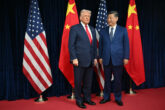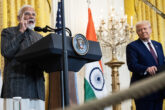August 11, 2014
The Shanghai Cooperation Organization: A Fading Star?
The Shanghai Cooperation Organization (SCO) stands at a pivotal point in its history. On the one hand, the growing ties between Russia and China as well as the withdrawal of the Western powers from Central Asia and Afghanistan could provide it with more cohesive leadership and more opportunities to become Eurasia’s dominant security institution. On the other hand, the SCO faces competition from the Russian-led Collective Security Treaty Organization (CSTO) and the new Eurasian Union as well as the Conference on Interaction and Confidence Building in Asia (CICA), a body that has labored in the SCO’s shadow but has recently attracted the interest of China, historically the SCO’s main champion.
To the surprise of many, including its members, the SCO rapidly became one of Eurasia’s most influential multinational institutions. The SCO’s original purpose was to regularize relations between China and its four, new, post-Soviet neighbors following the Soviet Union’s breakup and the end of the Sino-Soviet military confrontation, which sealed the borders between China and its western neighbors. After a series of annual heads-of-state summits among these “Shanghai Five,” the participating countries decided to formalize these ties in 2001 by creating a permanent organization and extending their initial border demilitarization talks to encompass broader security, economic, and other regional cooperation in Central Asia. At times during the mid-2000s, the media speculated that the SCO might become an “anti-NATO” bloc of pro-Moscow authoritarian states contesting regional primacy with the Western democracies. The SCO became one of the largest (in terms of geographic size and population) regional organizations with a most comprehensive agenda. The SCO has massive economic potential. Its members’ combined GDP ranks only behind the EU and the United States. The SCO’s full members (China, Russia, Kazakhstan, Kyrgyzstan, Tajikistan, and Uzbekistan) and formal observers (Afghanistan, India, Iran, Pakistan, and Mongolia) include some of the world’s leading energy exporters and importers, as well as major military powers (several with nuclear weapons). The SCO’s pivotal location means that its policies and developments could have important effects on neighboring regions in Asia, the Middle East, and even Europe.
More from CNAS
-
Indo-Pacific Security / Energy, Economics & Security
How to Win the Economic War with ChinaTrump's approach to China has run aground, giving Beijing unprecedented advantage in the economic conflict....
By Edward Fishman & Julian Gewirtz
-
America’s Self-Loathing Is a Losing Hand
This article was originally published in The Washington Post.Around 10 years ago, the United States began a historic shift in its grand strategy toward China, abandoning the b...
By David Feith
-
Indo-Pacific Security / Energy, Economics & Security / Technology & National Security
Selling AI Chips Won’t Keep China Hooked on U.S. TechnologyU.S. policy should not rest on the illusion that selling chips can trap China inside the American tech ecosystem....
By Janet Egan
-
Will New Delhi-Beijing Move Beyond Friction Points? | Ex-White Official On India-China Reset
Prime Minister Narendra Modi on Friday said that India and China, as two major economies, must work together to bring stability to the global economic order. NDTV's Gaurie Dwi...
By Lisa Curtis




